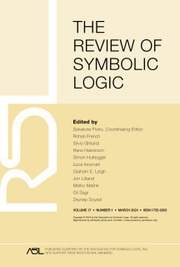Article contents
 $\gamma $-ADMISSIBILITY IN FIRST-ORDER RELEVANT LOGICS: PROOF USING NORMAL MODELS IN THE MARES–GOLDBLATT SETTING
$\gamma $-ADMISSIBILITY IN FIRST-ORDER RELEVANT LOGICS: PROOF USING NORMAL MODELS IN THE MARES–GOLDBLATT SETTING
Published online by Cambridge University Press: 12 December 2024
Abstract
For relevant logics, the admissibility of the rule of proof  $\gamma $ has played a significant historical role in the development of relevant logics. For first-order logics, however, there have been only a handful of
$\gamma $ has played a significant historical role in the development of relevant logics. For first-order logics, however, there have been only a handful of  $\gamma $-admissibility proofs for a select few logics. Here we show that, for each logic L
$\gamma $-admissibility proofs for a select few logics. Here we show that, for each logic L of a wide range of propositional relevant logics for which excluded middle is valid (with fusion and the Ackermann truth constant), the first-order extensions QL
of a wide range of propositional relevant logics for which excluded middle is valid (with fusion and the Ackermann truth constant), the first-order extensions QL and LQ
and LQ admit
admit  $\gamma $. Specifically, these are particular “conventionally normal” extensions of the logic
$\gamma $. Specifically, these are particular “conventionally normal” extensions of the logic  $\mathbf {G}^{g,d}$, which is the least propositional relevant logic (with the usual relational semantics) that admits
$\mathbf {G}^{g,d}$, which is the least propositional relevant logic (with the usual relational semantics) that admits  $\gamma $ by the method of normal models. We also note the circumstances in which our results apply to logics without fusion and the Ackermann truth constant.
$\gamma $ by the method of normal models. We also note the circumstances in which our results apply to logics without fusion and the Ackermann truth constant.
MSC classification
Information
- Type
- Research Article
- Information
- Copyright
- © The Author(s), 2024. Published by Cambridge University Press on behalf of The Association for Symbolic Logic
References
- 1
- Cited by


